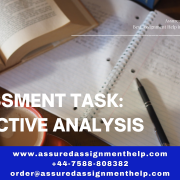Task: This is an individual assignment in which the student is required to answer all of the three problems included.
Value: 40 marks (40% of total assessment)
Due date: Week 13 (Sunday the 23th of October at 23.59 hours Darwin time)
Preparation: Topics 8-11.
Presentation: Online submission through Learnline.
Assessment Criteria:
This task will generally be assessed in terms of the following criteria:
- Effectiveness of communication: readability, grammar, spelling, neatness, completeness and presentation.
- Demonstrated competency and understanding: This will be evidenced by the student’s ability to be dialectical in the discussion of contentious issues. The marker will pay attention to the accuracy of the content, coverage of relevant issues, structure of argument, English expressions, absence of plagiarism, concise writing style, and referencing style.
- Evidence of research – This will be evidenced by the references used and the inclusion of a bibliography.
Submission of Assignments
- Assignments must be submitted by the due date.
- Failure to submit an assignment on or before the due date will result in an academic penalty of 5 % of the marks allocated for the assignment each day the assignment is overdue.
- All assignments must be submitted online. (Submissions via email will not be accepted)
- Students should include their names and students numbers clearly on the first page of the assignment. Please do not include a cover page.
- Assignment should be typed and submission file should be either word or pdf.
- Each page of the assignment should be numbered.
Assignment Extensions
All requests for extensions must be in writing and received seven days before the due assignment submission date. (Refer to Learnline for more details)
Assignment details:
Problem 1: (12 marks, max. 600 words)
Many companies have made shortening the production rate of various processes their primary goal. Most of these companies have reviewed costs and eliminated as much product as feasible. Now the focus is on speed. The commitment to speed affects every phase of a company’s business.
Administration, sales, engineering and production are all expected to complete tasks faster and more efficiently than ever before. Improved computer technologies have allowed companies to organise, synthesise and analyse information, giving firms that can operate a competitive advantage.
Required
i. Explain how faster processes can be applied in areas such as engineering and administration. How can reduced process times in these areas help a company be more competitive? (4 marks, max. 200 words)
ii. Explain why improved quality is essential to a company that is able to work faster and reduce process times. (4 marks, max. 200 words)
iii. What are potential problems that may arise from the increased speed of processes? (4 marks, max. 200 words)
Problem 2: (6 marks, max. 250 words)
Steve Smith is a manager of operations for XYZ Ltd. He is responsible for the operations of the company’s two manufacturing factories, one in Brisbane and one in Adelaide. Each factory has a manager who oversees the daily operations. During a recent review of the operations for the year, prepared using absorption costing, Steve noted that the Brisbane factory reported a net profit and that the balance in Finished goods inventory had grown significantly over the year. The Adelaide factory showed no net profit, but its inventory fell over the year. According to XYZ’s policy, the Brisbane factory manager will receive a bonus this year based on the profit generated at the factory; Adelaide manager will not receive a bonus.
Required
Comment on Steve’s observation. What conflicts are created when a company determines its manager’s bonuses based on net profit alone? (6 marks, max. 250 words)
Problem 3: (6 marks, max. 300 words)
Dream Housing Ltd produces prefabricated modular housing. The company manufactures four styles of homes and uses a standard cost accounting system. The company uses a single account for capturing material variances and another account for recording labour variances. During a review of the general ledger for the past operation period, Mr Dreamer, the managing director, notes that the material variances were favourable and the labour variances were unfavourable.
Required
i. In general, what do these variances indicate regarding production costs for the period?
(3 marks, max. 150 words)
ii. What further information would management find useful in analysing production costs and variances for the period? (3 marks, max. 150 words)
Required
i. Calculate the cost per unit for the variable costs and present the result in a table form. (4 marks, max. 100 words)
ii. Why do you think budget A has high costs and low sales forecasts? (4 marks, max. 100 words)
iii. Why do you think budget B has low costs and high sales forecasts? What are the behavioural implications of this top-down approach? (4 marks, max. 150 words)
iv. How should the two groups participate to come to a consensus on the budget? What are the advantages of this approach? (4 marks, max. 150 words)











